Exploring the Factors Influencing the Spread of COVID-19 Within Residential Communities Using a Big Data Approach: A Case Study of Beijing
Abstract
1. Introduction
Literature Review—Factors Influencing the Spread of COVID-19 in Residentail Areas
2. Methods—Exploring the Factors of COVID-19 Transmission in Residential Areas of Beijing
2.1. Study Area
2.2. Data and Methods
2.3. Quantifying COVID-19 Transmission and Related Factors
2.4. Selection of Research Sample
2.5. Data Preprocessing Summary
3. Results of Empirical Analysis
3.1. Logistic Regression Analysis Results
- (a)
- Number of People Aged 65 and Above (OR = 62.8, p < 0.001)
- (b)
- Density of Housing (OR = 9.96, p = 0.026)
- (c)
- Density of Population (β = −3.98, p < 0.001)
3.2. Collinearity Analysis
3.3. Confusion Matrix Validation
3.4. k-Fold Cross-Validation
3.5. Prediction Model for COVID-19 Transmission
3.6. Developing NPI Based on Modelling Results
4. Discussion—Towards Better Epidemic Control Through Urban Planning and Governance
4.1. Major Findings and Governance Implications
- (a)
- Critical role of elderly populations
- (b)
- Housing density as a transmission amplifier
- (c)
- Policy-mediated inverse density effect
4.2. Research Highlights
4.3. Limitations
5. Conclusions
Author Contributions
Funding
Data Availability Statement
Conflicts of Interest
References
- Qiu, Y.; Chen, X.; Shi, W. Impacts of social and economic factors on the transmission of coronavirus disease 2019 (COVID-19) in China. J. Popul. Econ. 2020, 33, 1127–1172. [Google Scholar] [CrossRef] [PubMed]
- Li, D.; Shao, Z.; Yu, W.; Zhu, X.; Zhou, S. Public Epidemic Prevention and Control Services Based on Big Data of Spatiotemporal Location Make Cities More Smart. Geomat. Inf. Sci. Wuhan Univ. 2020, 45, 475–487, 556. [Google Scholar] [CrossRef]
- Zhang, L.-S.; Chen, Y.; Fan, R.; Wen, Y.-H.; Yang, H.; Li, L.; Liu, Y.-H.; Zheng, H.-Z.; Jiang, J.-J.; Qian, H.; et al. Risk Factors Associated with Indoor Transmission During Home Quarantine of COVID-19 Patients. Front. Public Health 2023, 11, 1170085. [Google Scholar]
- Fang, Y.H.; Gu, K.K. Exploration on geospatial risk assessment in China based on multiple data: A case study of COVID-19 data from January 1 to April 11, 2020. J. Geo-Inf. Sci. 2021, 23, 284–296. [Google Scholar] [CrossRef]
- Ding, X.T.; Yu, Z.Y.; Song, H.H.; Xie, Y.; Lv, K. Research on the distribution of natural focus diseases based on information entropy. J. Geo-Inf. Sci. 2019, 21, 1877–1887. [Google Scholar]
- Cao, C.; Li, G.; Zheng, S.; Cheng, J.; Lei, G.; Tian, K. Research on the environmental impact factors of Hand-Foot-Mouth disease in Shenzhen, China using RS and GIS technologies. In Proceedings of the 2012 IEEE International Geoscience and Remote Sensing Symposium, Munich, Germany, 22–27 July 2012; pp. 7240–7243. [Google Scholar]
- Liu, Y.; Chai, Y.-H.; Wu, Y.-F.; Zhang, Y.-W.; Wang, L.; Yang, L.; Shi, Y.-H.; Wang, L.-L.; Zhang, L.-S.; Chen, Y.; et al. Risk factors associated with indoor transmission during home quarantine of COVID-19 patients. Front. Public Health 2023, 11, 1170085. [Google Scholar]
- Xie, S.; Wang, Y.; Liu, Y.; Zhang, Y. Spatial big data analysis and visualization for epidemic prevention and control: A case study of COVID-19 in China. J. Clean. Prod. 2022, 279, 123537. [Google Scholar]
- Xie, Y.; Batty, M.; Zhao, K.; Chai, Y.; Heppenstall, A.; Longley, P. Big data for urban studies: Opportunities and challenges in the era of COVID-19 and beyond. Comput. Environ. Urban Syst. 2022, 88, 101689. [Google Scholar] [CrossRef]
- Ye, Y.; Fan, W.; Wang, H.F. Clustering of 2019 Novel Coronavirus Disease Epidemic in Henan Province. Chin. J. Public Health 2020, 36, 465–468. [Google Scholar]
- Fang, H.; Wang, L.; Yang, Y. Human mobility restrictions and the spread of the Novel Coronavirus (2019-nCoV) in China. J. Public Econ. 2020, 191, 104272. [Google Scholar] [CrossRef]
- Zhou, Q.F.; Long, R.N.; Huang, Z. Discussion on the Needs of Epidemic Transmission Models for Fine Urban Spatial Governance. Beijing Plan. Constr. 2020, 4, 28–30. [Google Scholar]
- Yang, J.Y.; Shi, B.X.; Shi, Y.; Li, Y. Construction of a Multi-Scale Spatial Epidemic Prevention System in High-Density Cities. City Plan. Rev. 2020, 44, 17–24. [Google Scholar]
- Bajardi, P.; Poletto, C.; Ramasco, J.J.; Tizzoni, M.; Colizza, V.; Vespignani, A. Human mobility networks, travel restrictions, and the global spread of 2009 H1N1 pandemic. PLoS ONE 2011, 6, e16591. [Google Scholar] [CrossRef] [PubMed]
- Bayrsaikhan, T.; Lee, J.; Kim, M.H.; Gim, T.-H.T. A seemingly unrelated regression model of the impact of COVID-19 risk perception on urban leisure place choices. Int. Rev. Spat. Plan. Sustain. Dev. 2021, 9, 30–40. [Google Scholar] [CrossRef] [PubMed]
- He, J.; Zhang, Y. Urban epidemic governance: An event system analysis of the outbreak and control of COVID-19 in Wuhan, China. Urban Stud. 2023, 60, 1707–1729. [Google Scholar] [CrossRef] [PubMed]
- Sharifi, A.; Khavarian-Garmsir, A.R.; Kamali, F.; Yamagata, Y. The COVID-19 pandemic: Impacts on cities and major lessons for urban planning, design, and management. Sci. Total Environ. 2020, 749, 142391. [Google Scholar] [CrossRef]
- Lee, V.J.; Ho, M.; Chen, W.K.; Aguilera, X.; Heymann, D.; Wilder-Smith, A. Epidemic preparedness in urban settings: New challenges and opportunities. Lancet Infect. Dis. 2020, 20, 527–529. [Google Scholar] [CrossRef]
- Xie, S.X.; Liu, C.H.; Zhou, X.M. The Construction of Urban Resilience and the Evolution of Planning Theory from the Perspective of Epidemic Prevention. Huazhong Archit. 2020, 10, 137–141. [Google Scholar]
- Song, X.; Cao, M.; Zhai, K.; Gao, X.; Wu, M.; Yang, T. The effects of spatial planning, well-being, and behavioural changes during and after the COVID-19 pandemic. Front. Sustain. Cities 2021, 3, 686706. [Google Scholar] [CrossRef]
- Honey-Roses, J.; Anguelovski, I.; Bohigas, J.; Chireh, V.; Daher, C.; Konijnendijk, C.; Litt, J.; Mawani, V.; McCall, M.K.; Orellana, A.; et al. The impact of COVID-19 on public space: A review of the emerging questions. Cities Health 2020, 1–16. [Google Scholar] [CrossRef]
- Weaver, A.K.; Head, J.R.; Gould, C.F.; Carlton, E.J.; Remais, J.V. Environmental Factors Influencing COVID-19 Incidence and Severity. Annu. Rev. Public Health 2022, 43, 271–291. [Google Scholar] [CrossRef]
- Boehm, A.B.; Wigginton, K.R. Environmental Engineers and Scientists Have Important Roles to Play in Stemming Outbreaks and Pandemics Caused by Enveloped Viruses. Environ. Sci. Technol. 2020, 54, 3736–3739. [Google Scholar] [CrossRef]
- Canada.ca. COVID-19: Guidance on Indoor Ventilation During the Pandemic. 2021. Available online: https://www.canada.ca/en/public-health/services/diseases/2019-novel-coronavirus-infection/guidance-documents/guide-indoor-ventilation-covid-19-pandemic.html (accessed on 1 January 2022).
- China Property Management Association, China Economic Information Service. Impact of the COVID-19 Pandemic on the Property Management Industry: A Survey Report. 2020. Available online: https://kns.cnki.net/dm8/manage/export.html?filename=Pe2nFq1PBOM11SpCErZ-LwM1UHjV0uMR_icN4IXwgidyz3lGWSThkCcypFHQXJ5yec0HoBMAn_O3Wp_5JSKve3-s4n4jlL7XQKLOuexh_op3KAUBlVIsgcb0E8u_YkCK&displaymode=NEW&uniplatform=NZKPT (accessed on 1 January 2023).
- Liu, Z.; Ye, Y.; Zhang, H.; Guo, H.; Yang, J.; Wang, C. Spatio-Temporal Characteristics and Transmission Path of COVID-19 Cluster Cases in Zhuhai. Trop. Geogr. 2020, 40, 422–431. [Google Scholar]
- Klompmaker, J.O.; Hart, J.E.; Holland, I.; Sabath, M.B.; Wu, X.; Laden, F.; Dominici, F.; James, P. County-level exposures to greenness and associations with COVID-19 incidence and mortality in the United States. Environ. Res. 2021, 199, 111331. [Google Scholar] [CrossRef] [PubMed] [PubMed Central]
- CNBC. Factors Affecting COVID-19 Spread among Lower-Income Communities. 2021. Available online: https://www.cnbc.com/2021/01/12/factors-affecting-covid-19-spread-among-lower-income-communities.html (accessed on 12 January 2021).
- Gurram, M.K.; Wang, M.X.; Wang, Y.C.; Pang, J. Impact of urbanisation and environmental factors on spatial distribution of COVID-19 cases during the early phase of epidemic in Singapore. Sci. Rep. 2022, 12, 9758. [Google Scholar] [CrossRef] [PubMed]
- CDC. Factors That Affect Your Risk of Getting Very Sick from COVID-19. 2023. Available online: https://archive.cdc.gov/#/details?q=https://www.cdc.gov/coronavirus/2019-ncov/your-health/risks-getting-very-sick.html&start=0&rows=10&url=https://www.cdc.gov/coronavirus/2019-ncov/your-health/risks-getting-very-sick.html (accessed on 11 May 2023).
- Shi, X. Urban morphology, urban ventilation and aerosol transmission of novel coronavirus: A written discussion on coping with the emergency of novel coronavirus pneumonia in 2020. Urban Plan. 2020, 44, 10. [Google Scholar]
- Li, X.; Zhou, L.; Jia, T.; Peng, R.; Fu, X.; Zou, Y. Associating COVID-19 Severity with Urban Factors: A Case Study of Wuhan. Int. J. Environ. Res. Public Health 2020, 17, 6712. [Google Scholar] [CrossRef]
- Kan, Z.; Kwan, M.P.; Wong, M.S.; Huang, J.; Liu, D. Identifying the space-time patterns of covid-19 risk and their associations with different built environment features in Hong Kong. Sci. Total Environ. 2021, 772, 145379. [Google Scholar] [CrossRef]
- Shen, J.; Hu, F.; Huang, J.X.; Wu, S. Review on Risk Factors Influencing the Spread of COVID-19. Huazhong-Archit. 2022, 40, 33–39. [Google Scholar] [CrossRef]
- Nguyen, Q.C.; Huang, Y.; Kumar, A.; Duan, H.; Keralis, J.M.; Dwivedi, P.; Meng, H.-W.; Brunisholz, K.D.; Jay, J.; Javanmardi, M.; et al. Using 164 Million Google Street View Images to Derive Built Environment Predictors of COVID-19 Cases. Int. J. Environ. Res. Public Health 2020, 17, 6359. [Google Scholar] [CrossRef]
- You, H.; Wu, X.; Guo, X. Distribution of COVID-19 Morbidity Rate in Association with Social and Economic Factors in Wuhan, China: Implications for Urban Development. Int. J. Environ. Res. Public Health 2020, 17, 3417. [Google Scholar] [CrossRef] [PubMed]
- Zheng, T.M.; Liu, H.L. Exploration of the Built-Environmental Elements that Influence the Spread of COVID-19 Pandemic on Community Scale: A Case Study of Wuhan, China. Mod. Urban Res. 2020, 10, 20–29. [Google Scholar]
- News Medical. Factors Affecting SARS-CoV-2 Transmission and Outbreak Control in Densely Populated Areas. 2021. Available online: https://www.news-medical.net/news/20210803/Factors-affecting-SARS-CoV-2-transmission-and-outbreak-control-in-densely-populated-areas.aspx (accessed on 3 August 2021).
- CDC. How Coronavirus Spreads. 2021. Available online: https://www.cdc.gov/coronavirus/2019-ncov/prevent-getting-sick/how-covid-spreads.html (accessed on 13 June 2024).
- CDC. Science Brief: SARS-CoV-2 and Surface (Fomite) Transmission for Indoor Community Environments. 2021. Available online: https://archive.cdc.gov/#/details?url=https://www.cdc.gov/coronavirus/2019-ncov/more/science-and-research/surface-transmission.html (accessed on 31 May 2024).
- Beijing Municipal Bureau of Statistics & National Bureau of Statistics Survey Office in Beijing. Statistical Communiqué on the National Economy and Social Development of Beijing in 2023; Beijing Municipal Bureau of Statistics & National Bureau of Statistics Survey Office in Beijing: Beijing, China, 2024.
- Li, Y.; Chu, Q.; Zhang, M.L.; Xie, X.Z. Urban Public Service Delivery. In Proceedings of the 2020 China Urban Planning Annual Conference (11 Urban-Rural Governance and Policy Research): Spatial Governance for High-Quality Development, Chengdu, China, 25 September 2021; Urban Planning Society of China: Beijing, China, 2021; pp. 180–193. [Google Scholar]
- Sporadic Cases and Interconnectedness of Community Transmission During the Pandemic: An Interview with Du Zhaohui, Expert of the Gansu Working Group Under the Joint Prevention and Control Mechanism of the State Council. Updated 15 October 2021. Available online: https://www.gov.cn/xinwen/2021-10/30/content_5647744.htm (accessed on 2 May 2025).
- Investigation on the Status Quo of Cognition, Prevention and Control of Novel Coronavirus Infection Pneumonia Among the Elderly at Home in Community and Analysis of Strategies. Updated 8 August 2020. Available online: https://www.qikanchina.com/thesis/view/4731218 (accessed on 30 May 2025).
- V, A.A.R.; R, V.; Haghighat, F. The contribution of dry indoor built environment on the spread of Coronavirus: Data from various Indian states. Sustain. Cities Soc. 2020, 62, 102371. [Google Scholar] [CrossRef] [PubMed]
- Bryan, M.S.; Sun, J.; Jagai, J.; Horton, D.E.; Montgomery, A.; Sargis, R.; Argos, M. Coronavirus disease 2019 (COVID-19) mortality and neighborhood characteristics in Chicago. Ann. Epidemiol. 2021, 56, 47–54. [Google Scholar] [CrossRef]
- Li, W.; Zhao, S.C.; Ji, X.C.; Ma, J.W. The impact of traffic exposure and land use patterns on the risk of COVID-19 transmission in communities. China J. Highw. Transp. 2020, 33, 43–54. [Google Scholar]
- Notice from the Beijing Municipal Commission of Housing and Urban Rural Development on Solidly Doing a Good Job in Epidemic Prevention and Control in Residential Communities. Updated 15 October 2021. Available online: https://www.beijing.gov.cn/ywdt/gzdt/202108/t20210804_2456608.html (accessed on 31 May 2025).
- Strictly Control Personnel Density, Shijingshan Laoshan Street Launches a Combination of Epidemic Prevention and Education Punches. Updated 18 February 2020. Available online: https://baijiahao.baidu.com/s?id=1658863895420690838&wfr=spider&for=pc (accessed on 18 February 2020).
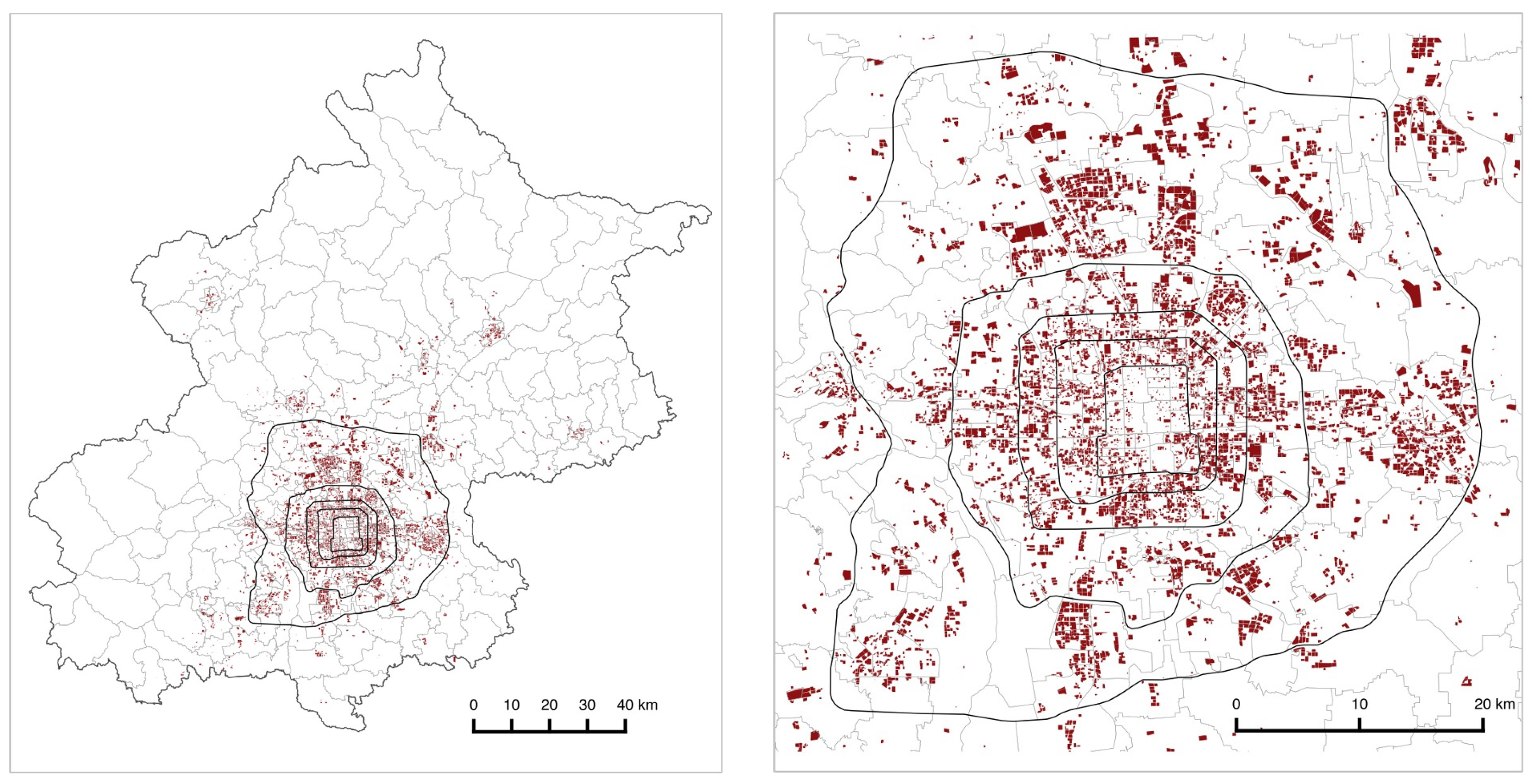
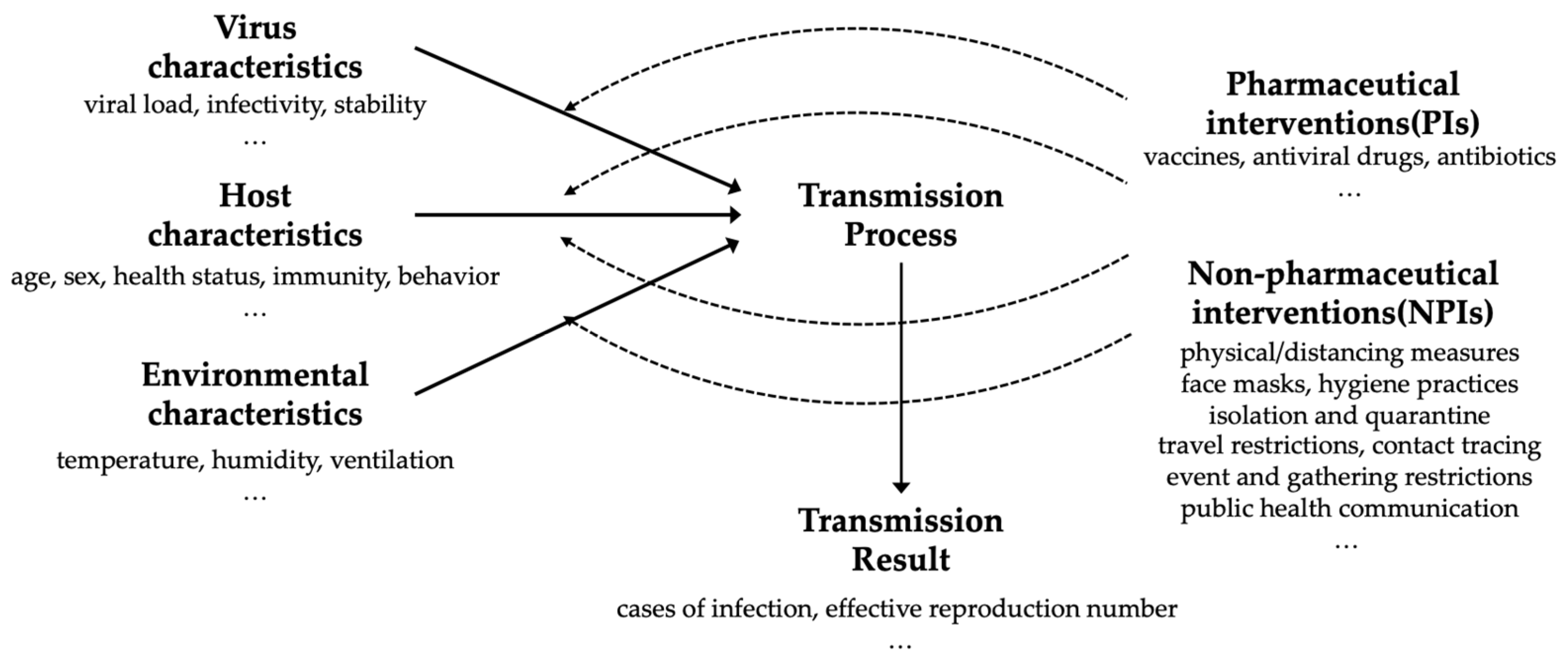
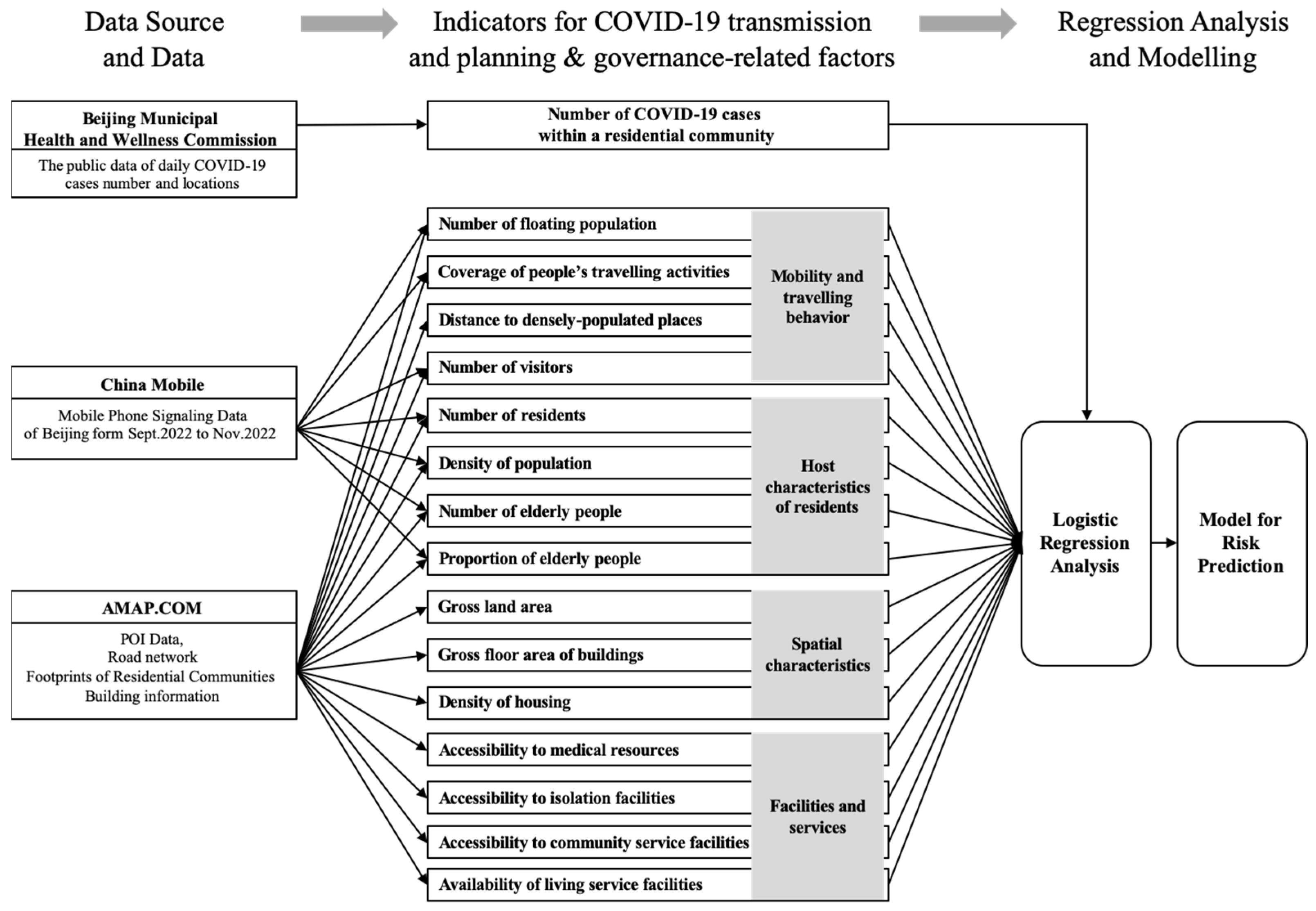
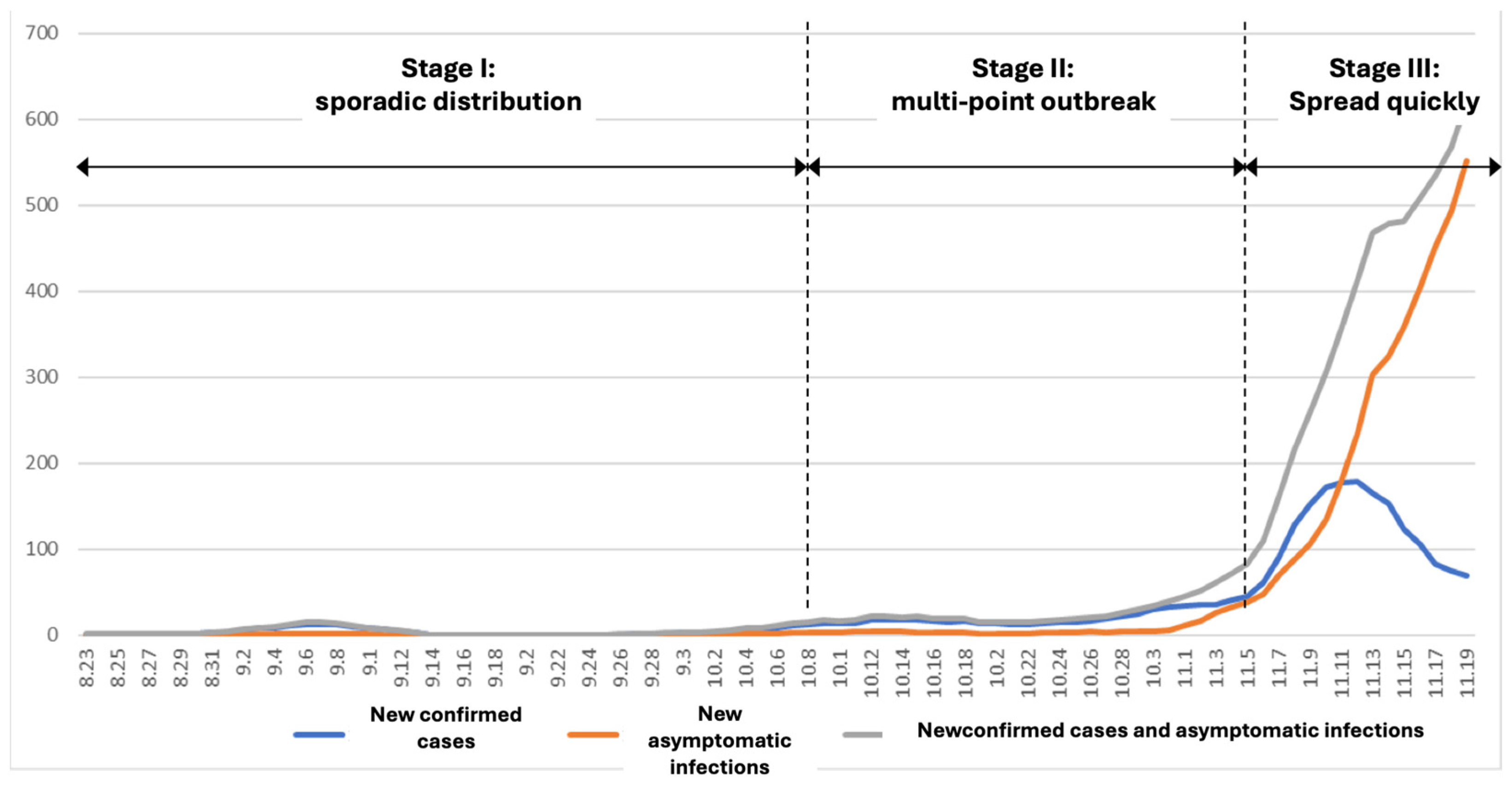
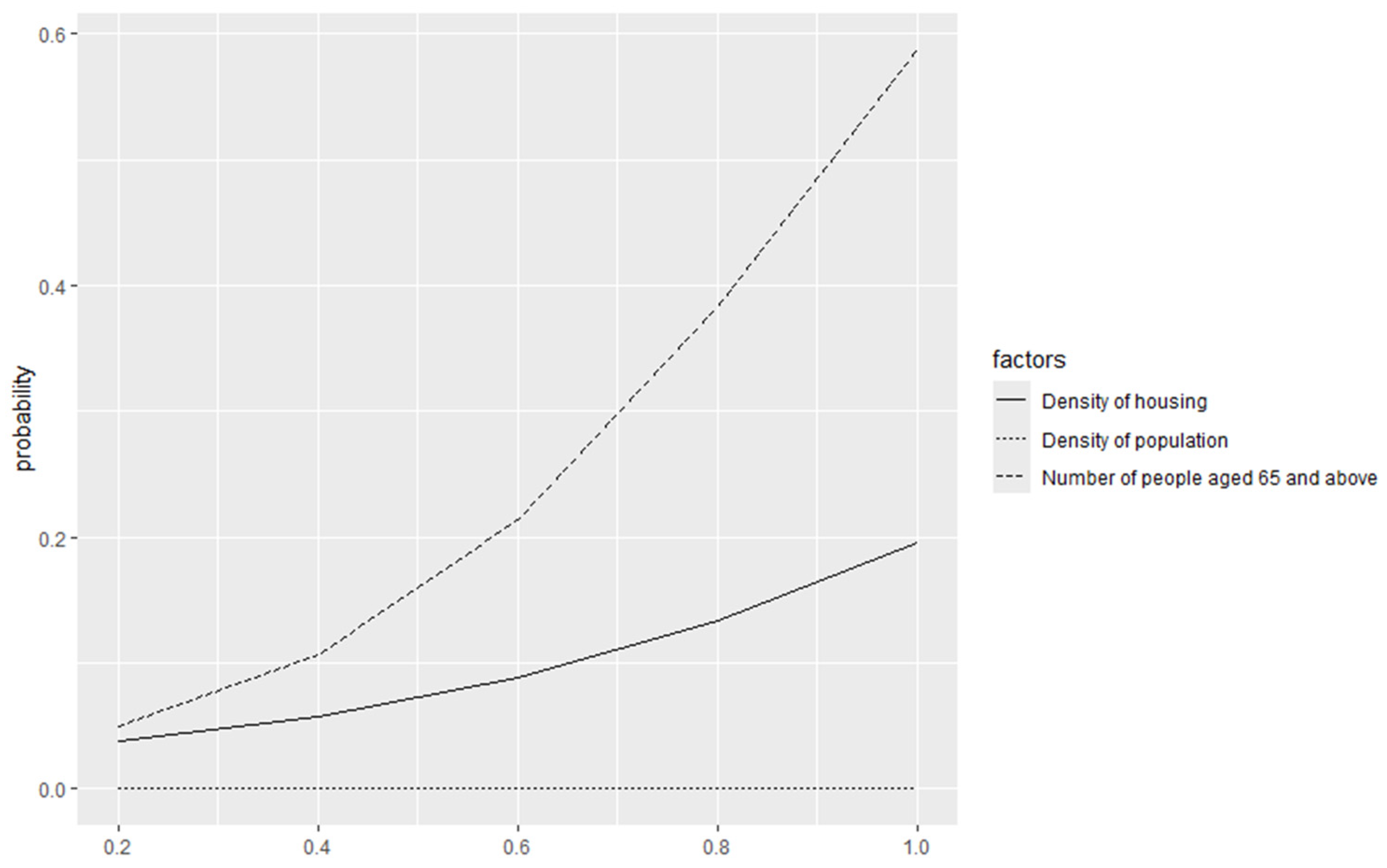
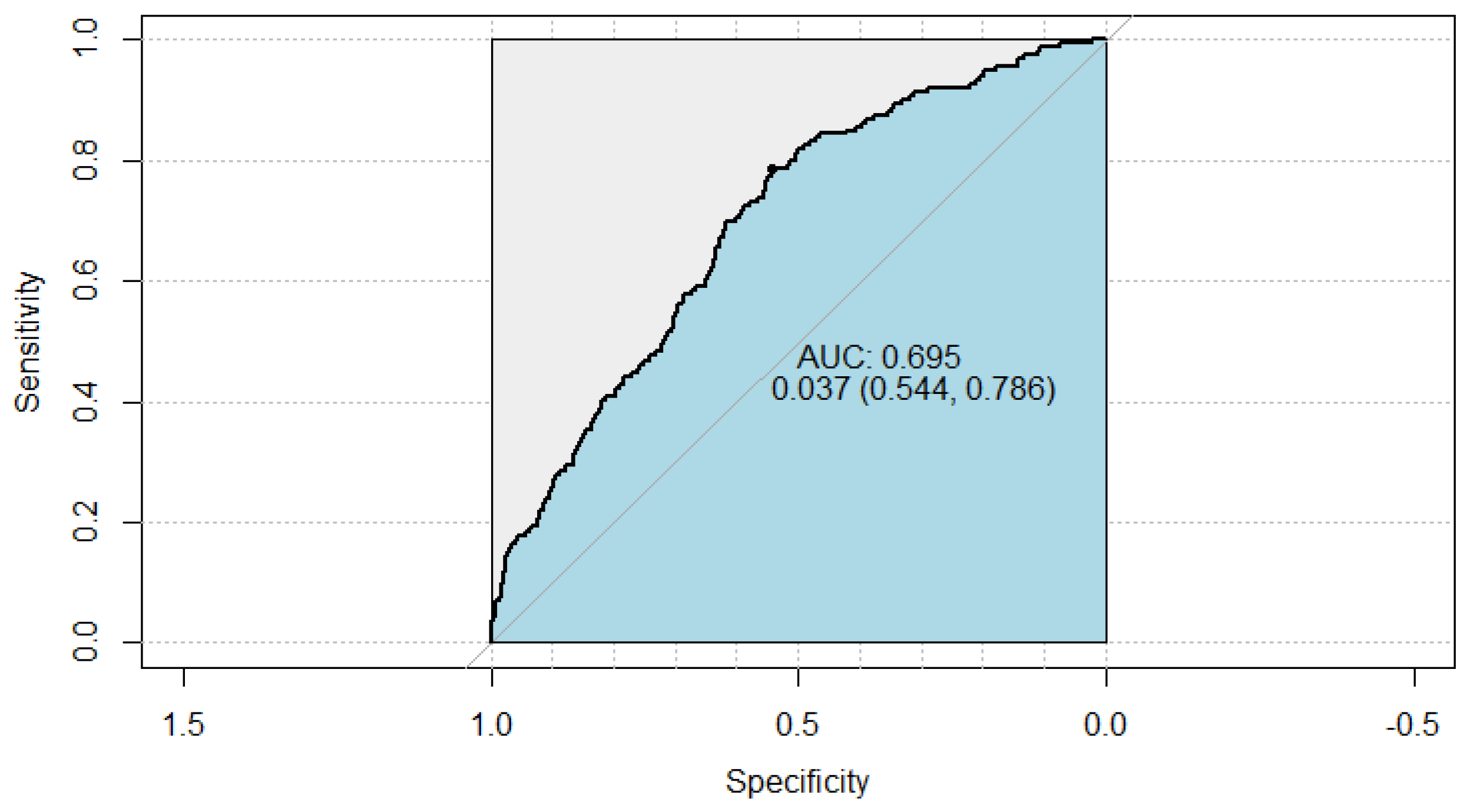

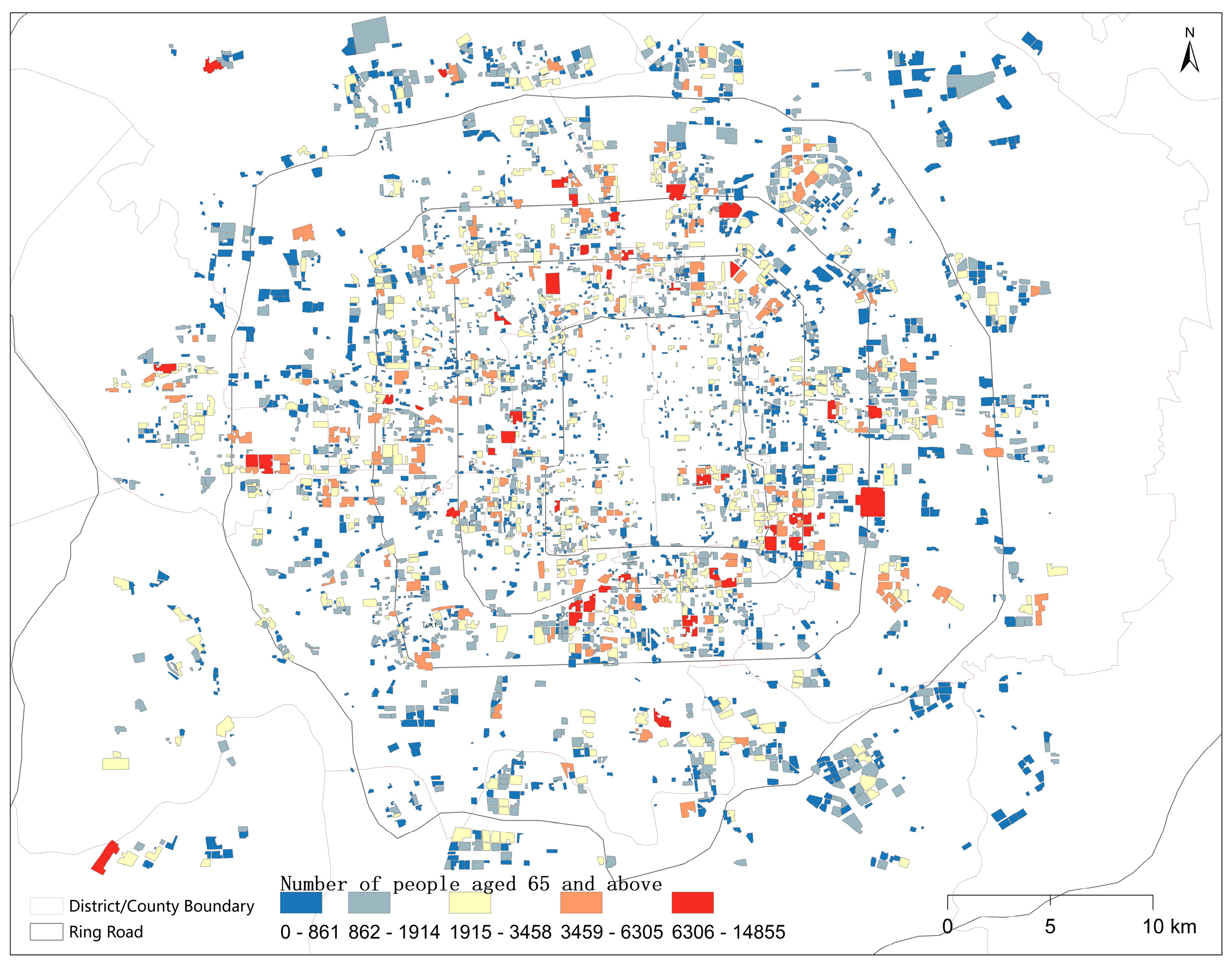
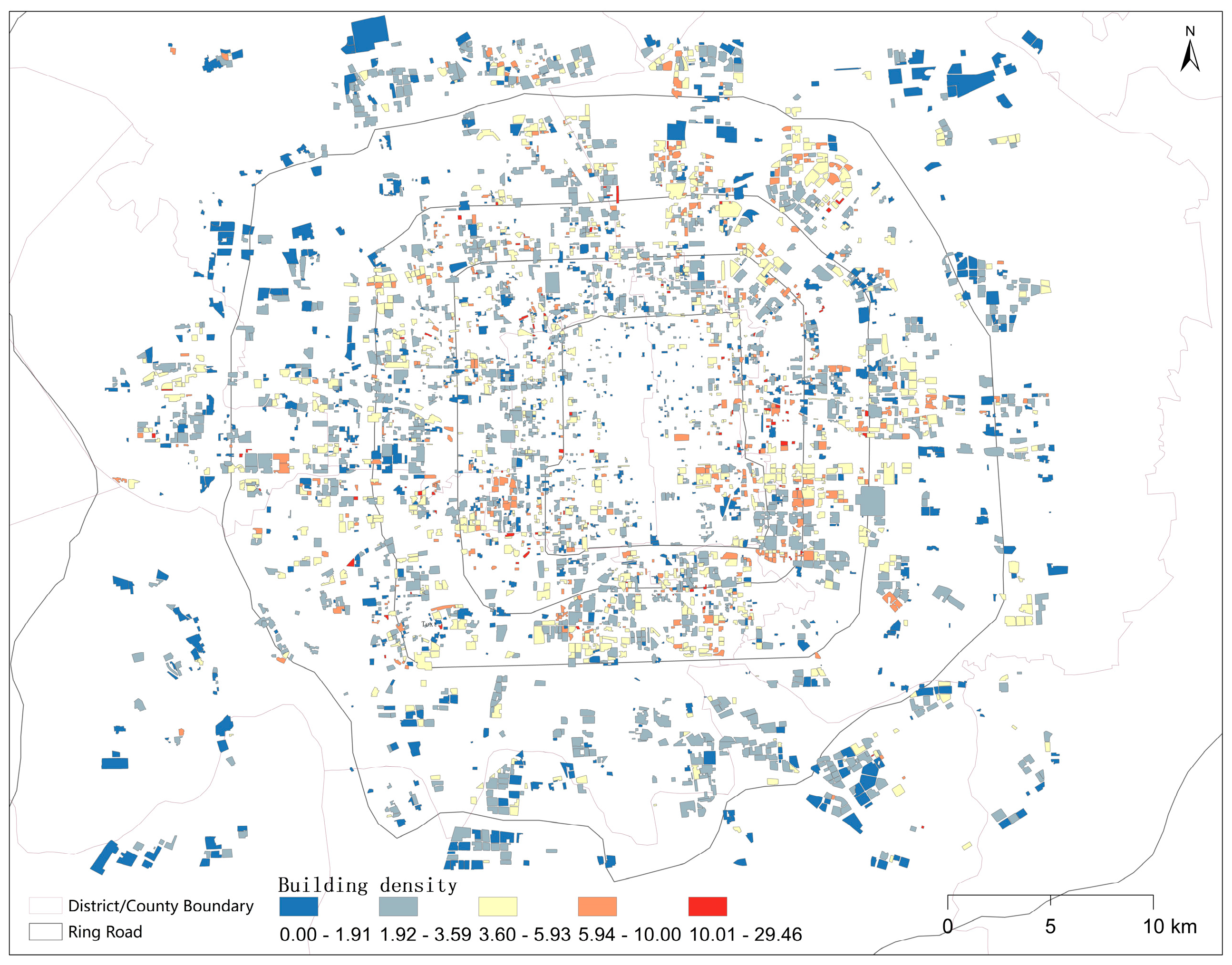
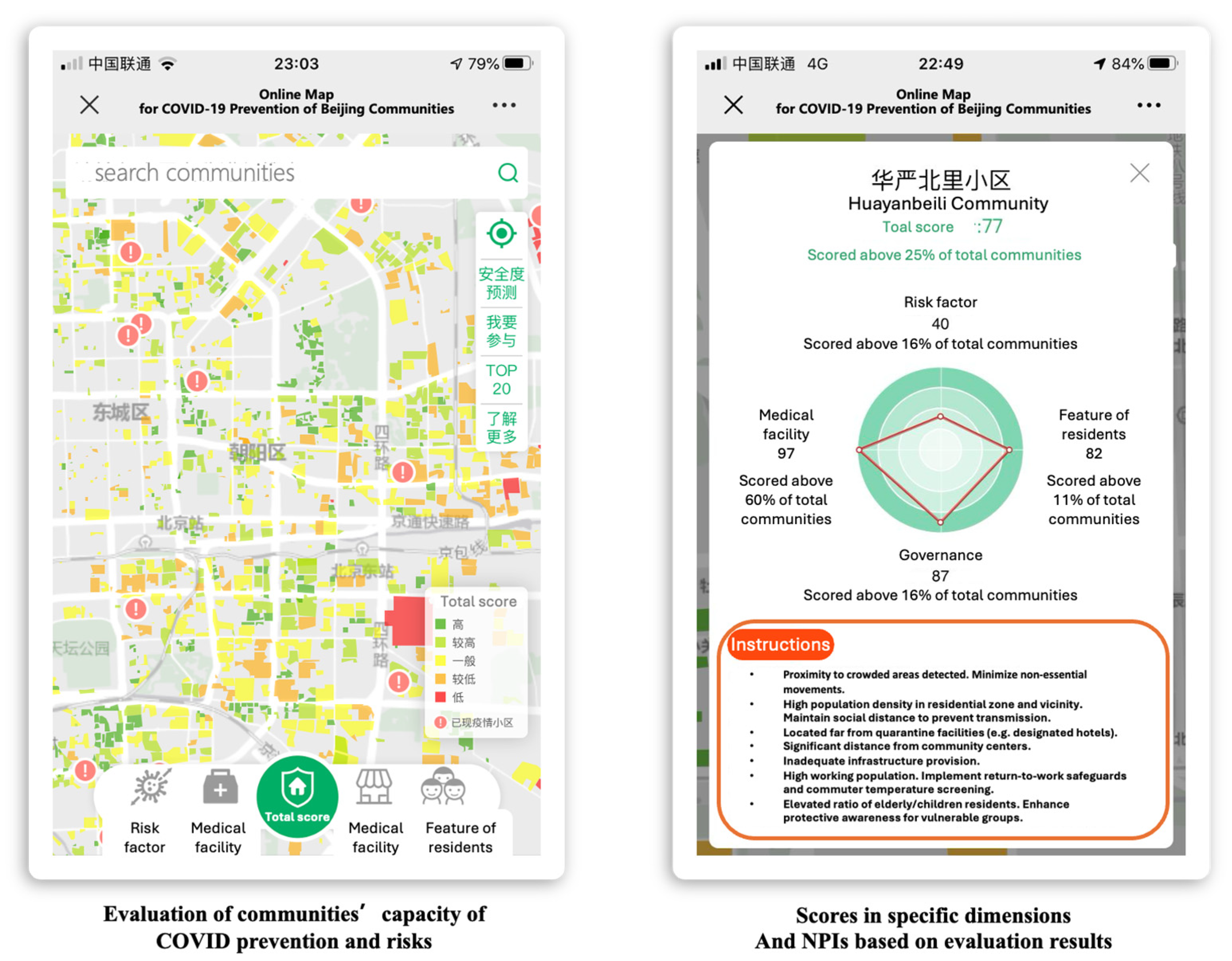
| Category | Indicator | Explanation | |
|---|---|---|---|
| Mobility and travelling behavior | 1 | Number of floating population | the number of people who live in the residential community less than 6 month per year, such as migrant workers |
| 2 | Coverage of people’s travelling activities | the total number of communities reached by the travels of persons from a certain residential community | |
| 3 | Distance to densely populated places | the spatial distance between a residential community and the nearest densely populated places such as airport, railway station or supermarket | |
| 4 | Number of visitors | the total number of visitors to a residential community | |
| Host characteristics of residents | 5 | Number of residents | the total number of population within a residential community |
| 6 | Density of population | the average number of population per hectare within a residential community | |
| 7 | Number of people aged 65 and above | the total number of persons older than 65 within a residential community | |
| 8 | Proportion of people aged 65 and above | the ratio of persons older than 65 and the total number of population within a residential community | |
| Spatial characteristics | 9 | Gross land area | the total land area of a residential community |
| 10 | Gross floor area of buildings | the total gross floor area (GFA) of buildings within a residential community | |
| 11 | Density of housing | the average gross floor area of buildings per hectare within a residential community | |
| Facilities and services | 12 | Accessibility to medical resources | the distance between a residential community and the nearest medical facility such as a hospital or a clinic |
| 13 | Accessibility to isolation facilities | the distance between a residential community and the nearest isolation facility for COVID-19 e.g., hotels | |
| 14 | Accessibility to community service facilities | the distance between a residential community and the nearest community service center | |
| 15 | Availability of living service facilities | The number and variability of living service facilities e.g., markets and open spaces | |
| Datasets | Details | Contents | Size of Records | Period | Data source | |
|---|---|---|---|---|---|---|
| Municipal data | Medical resources | Hospital | Name | 2186 | 2022 | Beijing Municipal Health and Wellness Commission |
| Level | ||||||
| Address | ||||||
| Confirmed cases data | Count of confirmed cases | Residential communities | 83 | 2022 | Beijing Municipal Health and Wellness Commission | |
| Count of confirmed cases | ||||||
| Community service facilities | / | Name | 203 | 2022 | data.beijing.gov.cn | |
| Address | ||||||
| Location | ||||||
| Geodata | Space units | Districts | Name | 16 | 2022 | Location-based internet service provider (AMAP.com) |
| Area | ||||||
| Sub districts | Name | 333 | ||||
| Residential community | Name | 6652 | ||||
| Density of housing | ||||||
| Point of interests (POI) | POIs | Category | ca. 0.3 million | 2022 | Location-based internet service provider (AMAP.com) | |
| Type | ||||||
| Address | ||||||
| Location | ||||||
| Road network | Name Level | ca. 0.51 million | ||||
| Mobile signaling data | Commuting data | Population in residential areas | ca. 251 million | September to November 2022 | Mobile phone communication service provider (China Mobile) | |
| Population in workplace | ||||||
| ID of grids | ||||||
| Population | gender | |||||
| age | ||||||
| Number of permanent inhabitants | ||||||
| Number of inhabitants | ||||||
| ID of grids | ||||||
| Grids data | ID of grids | |||||
| Coefficients | Estimate | Odds Ratio | Std.Error | Z Value | PR(>|ZL) |
|---|---|---|---|---|---|
| Intercept | −2.93 | 0.053 | 4.66 × 10−1 | −6.295 | 3.08 × 10−10 *** |
| Number of Floating Population | −4.34 | 0.013 | 4.71 | −0.922 | 0.356757 |
| Coverage of People’s Travelling Activities | 8.39 × 10−1 | 2.314 | 9.32 × 10−1 | 0.9 | 0.368045 |
| Distance to Densely Populated Places | −1.57 | 0.209 | 1.09 | −1.441 | 0.149551 |
| Density of Population | −3.98 | 0.000 | 1.05 × 104 | −3.794 | 0.000148 *** |
| Number of People aged 65 and above | 4.14 | 62.801 | 1.04 | 3.99 | 6.62 × 10−5 *** |
| Proportion of People aged 65 and above | −2.70 × 10−1 | 0.763 | 1.40 | −0.193 | 0.846719 |
| Gross Land Area of Community | 2.99 | 19.795 | 2.62 | 1.141 | 0.25376 |
| Density of Housing | 2.30 | 9.956 | 1.03 | 2.229 | 0.025816 * |
| Std. Value | Probability of Case Occurrence Affected by | |
|---|---|---|
| Number of People Aged 65 and Above | Density of Housing | |
| 0.2 | 0.049 | 0.037 |
| 0.4 | 0.106 | 0.058 |
| 0.6 | 0.213 | 0.089 |
| 0.8 | 0.383 | 0.133 |
| 1 | 0.587 | 0.196 |
| Independent Variable | Variance Inflation Factor (VIF) |
|---|---|
| Number of Floating Population | 3.8776 |
| Coverage of Residential Activities | 2.5780 |
| Distance to Densely Populated Places | 1.0543 |
| Population Density | 1.3262 |
| Number of population aged 65 and above | 3.3629 |
| Proportion of population aged 65 and above | 1.6025 |
| Gross Land Area | 1.9257 |
| Housing Density | 1.0955 |
| Confusion Matrix and Statistics | |||
|---|---|---|---|
| Reference | |||
| 0 | 1 | ||
| Prediction | 0 | 3739 | 157 |
| 1 | 0 | 2 | |
| Accuracy | 0.9597 | ||
| 95% Confidence Interval | (0.9531, 0.9657) | ||
| No Information Rate (NIR) | 0.9592 | ||
| p-Value [Acc > NIR] | 0.4565 (p > 0.05) | ||
| Cohen’s Kappa | 0.0239 | ||
| McNemar’s Test p-Value | <2.0 × 10−16 | ||
| Specificity | 0.01258 | ||
| Pos Pred Value (PPV) | 0.95970 | ||
| Neg Pred Value (NPV) | 1.00000 | ||
| Prevalence | 0.95921 | ||
| Detection Rate | 0.95921 | ||
| Detection Prevalence | 0.99949 | ||
| Balanced Accuracy | 0.50629 | ||
| ‘Positive’ Class | 0 | ||
| Cross-Validation Error Metric | Value |
|---|---|
| Raw CV Error Estimate (Mean across folds) | 0.03821481 |
| Bias-Adjusted CV Error Estimate | 0.03820028 |
| Probability of Case Occurrence | Frequency | Frequency Proportion |
|---|---|---|
| 0–0.01 | 284 | 7.12% |
| 0.01–0.02 | 385 | 9.65% |
| 0.02–0.03 | 711 | 17.82% |
| 0.03–0.04 | 932 | 23.36% |
| 0.04–0.05 | 739 | 18.53% |
| 0.05–0.06 | 347 | 8.70% |
| 0.06–0.07 | 198 | 4.96% |
| 0.07–0.08 | 85 | 2.13% |
| 0.08–0.09 | 58 | 1.45% |
| 0.09–0.1 | 37 | 0.93% |
| 0.1–1 | 122 | 3.06% |
| Risk Factor | Focus of Non-Pharmaceutical Interventions (NPIs) | Corresponding Non-Pharmaceutical Interventions (NPIs) |
|---|---|---|
| High proportion of elderly residents | protect the elderly from exposure and infection, as well as to support their physical and mental well-being during the pandemic. |
|
| High housing density | reduce the transmission risk within and between households, as well as to improve the environmental quality and ventilation. |
|
Disclaimer/Publisher’s Note: The statements, opinions and data contained in all publications are solely those of the individual author(s) and contributor(s) and not of MDPI and/or the editor(s). MDPI and/or the editor(s) disclaim responsibility for any injury to people or property resulting from any ideas, methods, instructions or products referred to in the content. |
© 2025 by the authors. Licensee MDPI, Basel, Switzerland. This article is an open access article distributed under the terms and conditions of the Creative Commons Attribution (CC BY) license (https://creativecommons.org/licenses/by/4.0/).
Share and Cite
Li, Y.; Sun, X.; Chen, H.; Zhang, H.; Li, Y.; Lin, W.; Ding, L. Exploring the Factors Influencing the Spread of COVID-19 Within Residential Communities Using a Big Data Approach: A Case Study of Beijing. Buildings 2025, 15, 2186. https://doi.org/10.3390/buildings15132186
Li Y, Sun X, Chen H, Zhang H, Li Y, Lin W, Ding L. Exploring the Factors Influencing the Spread of COVID-19 Within Residential Communities Using a Big Data Approach: A Case Study of Beijing. Buildings. 2025; 15(13):2186. https://doi.org/10.3390/buildings15132186
Chicago/Turabian StyleLi, Yang, Xiaoming Sun, Huiyan Chen, Hong Zhang, Yinong Li, Wenqi Lin, and Linan Ding. 2025. "Exploring the Factors Influencing the Spread of COVID-19 Within Residential Communities Using a Big Data Approach: A Case Study of Beijing" Buildings 15, no. 13: 2186. https://doi.org/10.3390/buildings15132186
APA StyleLi, Y., Sun, X., Chen, H., Zhang, H., Li, Y., Lin, W., & Ding, L. (2025). Exploring the Factors Influencing the Spread of COVID-19 Within Residential Communities Using a Big Data Approach: A Case Study of Beijing. Buildings, 15(13), 2186. https://doi.org/10.3390/buildings15132186




